9 August 2024 : Daily Current Affairs
1. DNA profiling and its value in establishing guilt or innocence
- 1. DNA profiling and its value in establishing guilt or innocence
- 2. On monetary policy and financial markets
- 3. Why Himalayan towns need a different kind of development
- 4. Antarctica Faces Unprecedented Winter Heatwave: Record Temperatures Threaten Ice Sheet Stability and Global Climate
- 5. Jammu & Kashmir’s Economic Recovery: Tourism Soars, But Fundamental Challenges Persist
- 6. Impact of Glacial Lake Outburst Floods
- Prelims Facts
- 1. WORLD HERITAGE SITES IN INDIA
- 2. China Discovers Massive Gas Field in Disputed South China Sea, Escalating Regional Tensions
- 3. RBI Increases UPI Transaction Limit for Tax Payments to Rs 5 Lakh
- 4. India underlines elite status with podium finish again
- 5. Arshad’s 92.97m dethrones Neeraj
(Source – The Hindu, International Edition – Page No. – 7)
| Topic: GS3 – Science and Technology |
| Context |
|
Definition and Concept of DNA Profiling
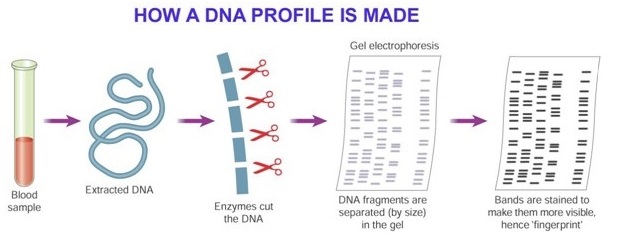
- DNA Profiling Definition: DNA profiling, also known as genetic fingerprinting, is a forensic technique used to identify individuals by analysing specific patterns in their DNA. These patterns are unique to each individual (except identical twins) and are used to match DNA samples from crime scenes with suspects.
- Concept of DNA Profiling:
- DNA Structure: DNA, or deoxyribonucleic acid, is the hereditary material in humans and other organisms. It consists of sequences of four nucleotides (adenine, guanine, thymine, and cytosine) that form a unique genetic code.
- STRs: DNA profiling focuses on short tandem repeats (STRs), which are repetitive sequences of DNA at specific locations (loci). The number of times these sequences repeat varies among individuals, providing a unique DNA profile.
- Loci Examination: In forensic DNA profiling, a few specific loci are chosen to create a DNA profile. By comparing these loci, forensic scientists can determine whether two DNA samples match.
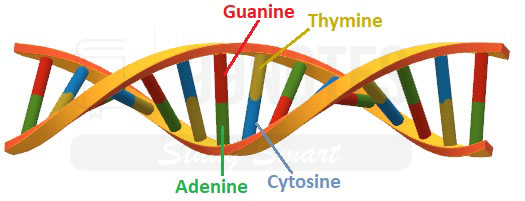
Value in Establishing Guilt or Innocence
- Identification: DNA profiling is a powerful tool for identifying or excluding suspects in criminal investigations by matching DNA from a crime scene with potential perpetrators.
- Corroborative Evidence: While DNA evidence can strongly support a case, it is often used in conjunction with other types of evidence (e.g., eyewitness testimony, physical evidence) to establish guilt or innocence.
- Limitations: The reliability of DNA evidence depends on proper collection, storage, and analysis of samples. Contamination, degradation, or mishandling of DNA samples can lead to inconclusive or inaccurate results.
- Probability-Based: DNA analysis is based on probability, meaning it can provide a statistical likelihood of a match rather than absolute certainty. The random occurrence ratio helps indicate how common a particular DNA profile might be.
- Non-Exclusivity: A match does not conclusively prove identity, as similar profiles can occur in unrelated individuals. DNA evidence should be considered alongside other evidence in court to establish guilt or innocence.
- Investigation vs. Courtroom: DNA profiling is highly valuable for investigative purposes, guiding police in identifying suspects, but its role in court relies on corroboration and the context of the case.
| Practice Question: Discuss the role and limitations of DNA profiling in criminal investigations and its impact on the judicial process in India. How should the legal system address the challenges associated with relying solely on DNA evidence? (250 Words /15 marks) |
2. On monetary policy and financial markets
(Source – The Hindu, International Edition – Page No. – 10)
| Topic: GS3 – Indian Economy |
| Context |
|
Global Economic Uncertainty
Despite a seeming recovery in global financial markets after significant value drops, the global economy remains uncertain.
- Employment generation in the U.S. is weaker than expected, threatening post-pandemic recovery efforts.
- The Bank of Japan’s decision to raise interest rates after maintaining them at low levels for years has unsettled financial markets, causing a reversal in equity flows and a decline in Asian markets.
These developments highlight the challenges central banks face in combating inflation and sluggish economic activity through interest rate adjustments.
Recession Fears and Monetary Policy
The common approach to monetary policy involves a trade-off between unemployment and inflation.
- Central banks typically raise interest rates to combat rising inflation, which reduces investment and aggregate demand, leading to decreased labour demand and easing inflationary pressures.
- Critics argue that this approach unfairly burdens workers already dealing with a cost-of-living crisis and suggest tackling inflation by reducing company profit margins and breaking monopolies.
- A weaker-than-expected U.S. jobs report sparked fears of recession and triggered a sell-off in equity markets, exacerbated by concerns over the performance of major tech companies.
- The economy was not in a recession, but market expectations alone led to panic among investors.
| What Is Monetary Policy? |
|
Market Reactions and Financial Sector Impact
- The rise in unemployment rates triggered the “Sahm rule,” which involves automatic disbursement of unemployment checks when unemployment increases significantly, correlating with potential recession indicators.
- This situation highlights the challenges of conducting monetary policy in a financial sector where market reactions can be swift and outpace policy responses.
The Carry Trade and Global Finance
- The Bank of Japan’s interest rate increase disrupted the “carry trade,” where investors borrowed at low rates in Japan to invest in foreign markets.
- The rate hike led to higher borrowing costs and selling pressures in other markets as investors adjusted their portfolios.
- Domestic policy decisions, such as low interest rates in Japan, have significant ripple effects on global financial activities and other economies.
Challenges for Monetary Policy
- Financial markets’ recovery suggests recession fears may be exaggerated, but vulnerabilities persist.
- These events underscore the destabilising potential of global finance and the challenges it poses to effective monetary policy.
- The rapid movement of financial assets across borders adds complexity to national economic policies, aligning with Keynes’s view on the instability of finance-driven capital development.
| Practice Question: Discuss the challenges faced by central banks in implementing monetary policy in an interconnected global economy, with a focus on the impact of financial market volatility and cross-border capital flows. (150 Words /10 marks) |
3. Why Himalayan towns need a different kind of development
(Source – The Hindu, International Edition – Page No. – 10)
| Topic: GS1 – Indian Society – Urbanization, their problems and their remedies, GS3 – Environment – Environmental pollution and degradation |
| Context |
|

Challenges in Indian Himalayan Range (IHR) Towns
- Urban Growth Rate: The Indian Himalayan Range (IHR), spanning 11 States and two Union Territories, experienced a decadal urban growth rate exceeding 40% from 2011 to 2021. This rapid expansion of towns and settlements highlights the need for a tailored approach to urbanisation in the region.
- Civic Management Issues: Himalayan towns, including major cities like Srinagar, Guwahati, Shillong, and Shimla, struggle with managing civic issues such as sanitation, waste management, and water supply. Planning institutions often rely on models suited to plain areas, which fail to address the unique challenges of the mountainous terrain.
- Resource Shortages: Many cities face severe shortages in human resources, with some areas, like the Kashmir Valley, having significantly fewer executive officers than needed.
- Depletion of natural landscapes: Towns are expanding into rural areas, leading to the depletion of open spaces, forest land, and water resources. For instance, Srinagar has seen a 75.58% increase in built-up areas between 2000 and 2020, with significant reductions in water bodies and increases in unregulated waste.
Causes of Urbanisation Challenges
- Pressure from Urbanisation: The IHR faces intensified urbanisation pressures, exacerbated by high tourism, unsustainable infrastructure development, and climatic changes like altered precipitation and rising temperatures. These factors contribute to water scarcity, deforestation, land degradation, and pollution.
- Tourism Impact: Tourism in the IHR has grown rapidly, leading to the replacement of eco-friendly infrastructure with poorly designed and environmentally damaging constructions. Ecotourism is essential for maintaining long-term sustainability.
Recommendations for Improvement
- Updated Planning Processes: Urban planning in IHR should involve detailed mapping that includes geological and hydrological vulnerabilities. Climate resilience should be a key focus in the planning process, with local involvement and a bottom-up approach.
- Financial Support: IHR cities cannot independently fund their infrastructure needs. The Finance Commission should address this by increasing intergovernmental transfers to at least 1% of GDP and ensuring that urban financing needs are met.
- Sustainable Development: A shift towards eco-centric urban planning, incorporating public participation and focusing on sustainability, is crucial for the future of Himalayan towns.
| PYQ: Discuss various social problems which originated out of the speedy process of urbanisation in India. (200 words/10m) (UPSC CSE (M) GS-1 2013) |
| Practice Question: Discuss the challenges faced by urban planning in Himalayan towns due to rapid urbanisation and tourism. How can these towns adopt sustainable practices to address these issues? (150 Words /10 marks) |
4. Antarctica Faces Unprecedented Winter Heatwave: Record Temperatures Threaten Ice Sheet Stability and Global Climate
(Source: Indian Express; Section: Explained; Page: 19)
| Context: |
|
Analysis of News:
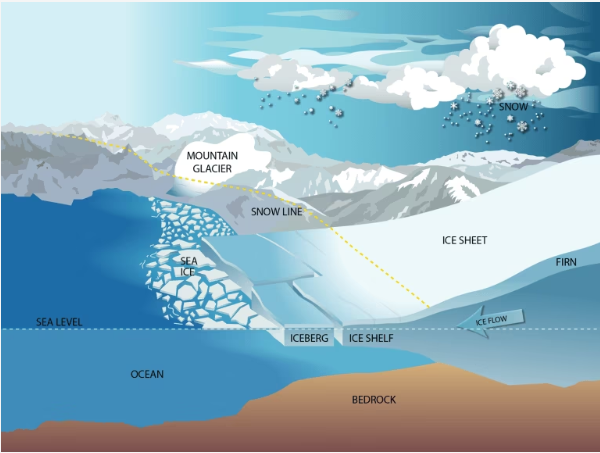
What do Ice Sheets Represent and How Do They Affect Sea Levels?
- An ice sheet is essentially a mass of glacial ice that covers more than 50,000 square kilometers of land.
- An ice sheet, such as the West Antarctic ice sheet, covers vast land areas, holding a substantial amount of freshwater.
- The two major ice sheets in the world, Greenland and Antarctica, collectively possess around two-thirds of the Earth’s freshwater.
- When ice sheets gain or lose mass, they respectively contribute to a fall or rise in global mean sea levels.
Causes of the Heatwave
- The primary cause of the elevated temperatures is the weakening of the polar vortex, a system of cold air that typically traps frigid temperatures over Antarctica.
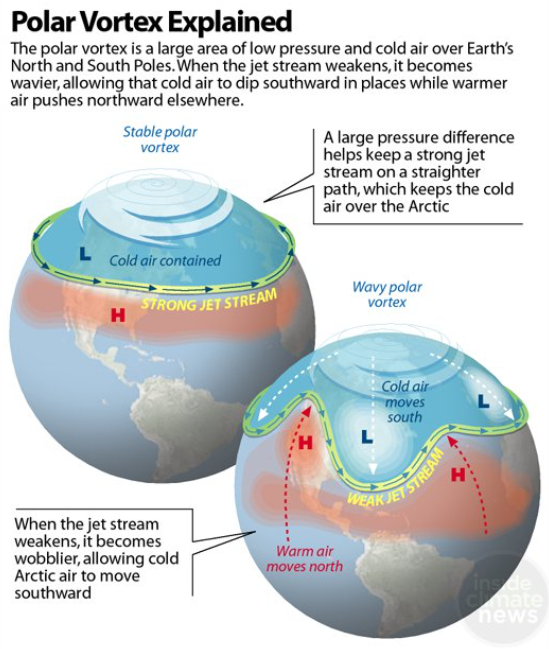
- This year, large-scale atmospheric waves disturbed the vortex, allowing warmer air to enter the region and increase ground temperatures.
- Additional contributing factors include the significant reduction in Antarctic sea ice, which typically helps maintain cooler temperatures by reflecting sunlight and acting as a barrier between cold air and warmer water.
Impact of Global Warming
- Antarctica is warming at nearly twice the rate of the rest of the planet, with temperatures increasing by 0.22°C to 0.32°C per decade.
- This accelerated warming exacerbates the continent’s vulnerability to heatwaves and other extreme weather events.
Potential Consequences
- The heatwave could lead to further loss of the Antarctic Ice Sheet, which holds over 60% of the world’s freshwater.
- If the ice sheet melts significantly, it could raise global sea levels by hundreds of feet, threatening coastal cities and displacing millions of people.
- Additionally, the melting ice is slowing down the global ocean circulation system, which could intensify global warming and lead to more frequent extreme weather events like floods and droughts.
Implications for India and Vulnerable Coastal Regions:
- India, with its extensive coastline and dense population, is particularly susceptible to sea level rise.
- Coastal communities might face displacement or become climate refugees if unable to fortify against rising seas, highlighting the urgency for adaptive strategies such as building protective infrastructure.
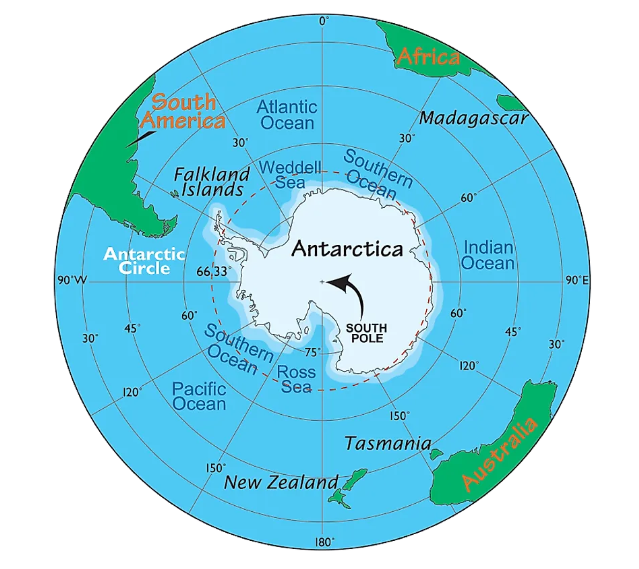
| What Actions has India Taken Related to Antarctica? |
|
| Practice Question: Discuss the potential global implications of rising temperatures in Antarctica, particularly in terms of sea-level rise and the disruption of global ocean circulation. (150 words/10 m) |
5. Jammu & Kashmir’s Economic Recovery: Tourism Soars, But Fundamental Challenges Persist
(Source: Indian Express; Section: Govt & Politics; Page: 10)
Topic: GS2 – Governance
| Context: |
| Jammu & Kashmir’s economy shows signs of recovery with a tourism boom and private investments, but continues to face deep-rooted structural challenges. |
Analysis of News:
Economic Analysis of Jammu & Kashmir
- Tourism Boom: A surge in tourism in Srinagar and record tourist arrivals in the Valley signal economic recovery post-COVID-19, with tourism contributing 7% to GSDP. However, private investment in tourism remains low, with only five hotels participating in the New Industrial Scheme despite tax incentives.
- Economic Challenges: Jammu & Kashmir (J&K) faces persistent economic issues, including heavy reliance on Central funds, high power purchase costs, ballooning salary and pension expenses, and a significant fiscal deficit of Rs 13,122 crore in 2023-24, more than triple the budgeted amount.
- Sectoral Dynamics: The economy is service-driven, with the sector contributing two-thirds to the Gross State Value Added and employing 31% of the workforce. Agriculture remains the primary employer, but efforts to boost productivity have yet to show significant results.
- Private Investment: The administration is focusing on attracting private investment, with Rs 6,625 crore realized out of Rs 1.26 lakh crore in proposals. Notable investments include textile, IT services, and aluminum manufacturing units. However, land acquisition challenges and a depleted land bank may hinder further investment.
- Power Sector Issues: J&K is power-deficient, with only 3,500 MW of installed capacity, which drops significantly in winter. Despite efforts to modernize infrastructure and reduce distribution losses, the region still faces power cuts due to a gap between demand and supply.
- Regional Disparities: Jammu has attracted 60% of investments, mainly from outsiders, due to better land availability and connectivity, while investments in Kashmir are predominantly by locals or expat Kashmiris, with challenges like connectivity and security concerns deterring outside investors.
| Practice Question: Despite signs of economic recovery in Jammu & Kashmir, fundamental structural challenges persist. Discuss the key issues hindering sustainable growth in the region and suggest measures to address them. (250 words/15 m) |
6. Impact of Glacial Lake Outburst Floods
(Source – https://pib.gov.in/PressReleseDetail.aspx?PRID=2042990 )
| Context |
|
What are Glacial Lake Outburst Floods (GLOFs)?
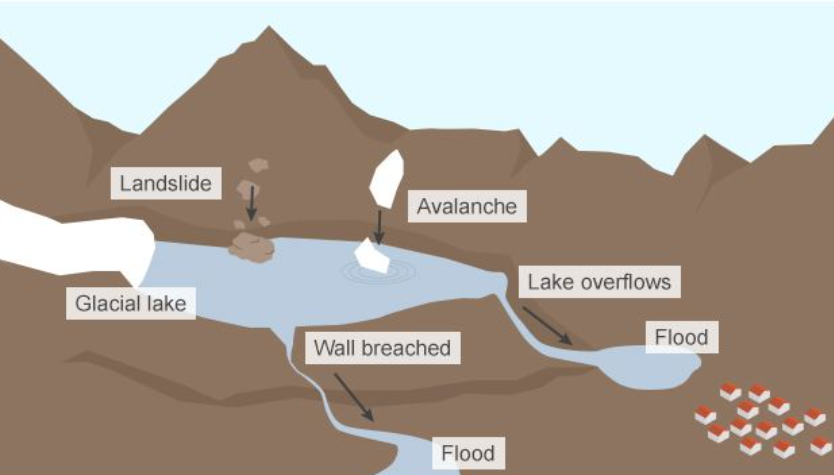
Definition
- Glacial Lake Outburst Floods (GLOFs): A GLOF occurs when a glacial lake, formed by the melting of glaciers, suddenly releases a significant amount of water.
- This sudden release often results in catastrophic flooding downstream, causing damage to infrastructure, ecosystems, and communities.
Reasons
- Glacial Retreat: The melting of glaciers due to climate change is accelerating the formation and expansion of glacial lakes. As these lakes grow, the risk of their natural barriers (like moraines) failing increases.
- Ice or Rock Avalanches: Avalanches can destabilise the moraine or ice dam holding the glacial lake, causing it to collapse and release water.
- Seismic Activity: Earthquakes can trigger landslides or directly destabilise the lake’s dam, leading to a sudden outburst.
- Excessive Rainfall or Snowmelt: Heavy rainfall or rapid snowmelt can increase the volume of water in a glacial lake beyond its capacity, causing overflow and dam failure.
Way Forward
- Early Warning Systems: Implement and maintain robust early warning systems to monitor glacial lakes and detect signs of potential outbursts.
- Regular Monitoring: Conduct frequent assessments of glacial lakes and their surroundings using remote sensing technology and on-ground surveys to identify high-risk areas.
- Structural Mitigation Measures: Construct controlled drainage channels or reinforce moraine dams to reduce the likelihood of sudden breaches.
- Community Awareness and Preparedness: Educate local communities about GLOF risks and develop evacuation plans to minimise loss of life and property.
- Research and Collaboration: Encourage scientific research to better understand GLOF dynamics and collaborate internationally to share knowledge and strategies for risk reduction.
| Practice Question: Discuss the causes and potential mitigation strategies for Glacial Lake Outburst Floods (GLOFs) in the Himalayan region. (150 Words /10 marks) |
Prelims Facts
1. WORLD HERITAGE SITES IN INDIA
(Source – https://pib.gov.in/PressReleseDetail.aspx?P RID=2043018)
| Topic: GS1 – Indian Culture |
| Context |
|
World heritage sites in India:
| Site and State | Year | Information |
| Agra Fort, Uttar Pradesh | 1983 | A Mughal fortress known for its architectural grandeur. |
| Ajanta Caves, Maharashtra | 1983 | Ancient Buddhist cave monuments famous for their paintings and sculptures. |
| Ellora Caves, Maharashtra | 1983 | Rock-cut temples representing Buddhist, Hindu, and Jain traditions. |
| Taj Mahal, Uttar Pradesh | 1983 | Iconic white marble mausoleum built by Mughal Emperor Shah Jahan. |
| Group of Monuments at Mahabalipuram, Tamil Nadu | 1984 | Ancient rock-cut architecture and sculptures dating back to the Pallava dynasty. |
| Sun Temple, Konarak, Odisha | 1984 | 13th-century temple known for its massive chariot-like structure dedicated to the Sun God. |
| Kaziranga National Park, Assam | 1985 | Home to the world’s largest population of Indian one-horned rhinoceroses. |
| Keoladeo National Park, Rajasthan | 1985 | Renowned bird sanctuary hosting numerous migratory birds. |
| Manas Wildlife Sanctuary, Assam | 1985 | A biodiversity hotspot with rare and endangered species, including the Assam roofed turtle. |
| Churches and Convents, Goa | 1986 | Historical Portuguese churches and convents representing colonial architecture. |
| Fatehpur Sikri, Uttar Pradesh | 1986 | A Mughal city known for its stunning palaces and religious buildings. |
| Group of Monuments at Hampi, Karnataka | 1986 | The ruins of a medieval Hindu kingdom with impressive temples and palaces. |
| Khajuraho Group of Monuments, Madhya Pradesh | 1986 | Known for their exquisite erotic sculptures and intricate carvings. |
| Elephanta Caves, Maharashtra | 1987 | Rock-cut cave temples dedicated to Lord Shiva. |
| Great Living Chola Temples at Thanjavur, Gangaikondacholapuran and Darasuram, Tamil Nadu | 1987 & 2004 | Exemplary Chola dynasty temples showcasing Dravidian architecture. |
| Group of Monuments at Pattadakal, Karnataka | 1987 | Blend of northern and southern Indian architectural styles in Hindu and Jain temples. |
| Sundarbans National Park, West Bengal | 1987 | Largest mangrove forest in the world, home to the Bengal tiger. |
| Nanda Devi and Valley of Flowers National Parks, Uttarakhand | 1988 & 2005 | Known for high-altitude biodiversity and stunning floral displays. |
| Buddhist Monuments at Sanchi, Madhya Pradesh | 1989 | One of the oldest and most significant Buddhist complexes in India. |
| Humayun’s Tomb, Delhi | 1993 | A precursor to the Taj Mahal and an example of Mughal garden-tomb architecture. |
| Qutb Minar and its Monuments, Delhi | 1993 | A collection of Islamic architecture, including the world’s tallest brick minaret. |
| Mountain Railways of India (Darjeeling, Nilgiri, Kalka – Shimla), West Bengal, Tamil Nadu, Himachal Pradesh | 1999, 2005, 2008 | Historic narrow-gauge railways showcasing engineering marvels of the colonial era. |
| Mahabodhi Temple Complex at Bodh Gaya, Bihar | 2002 | The location where Buddha attained enlightenment. |
| Rock Shelters of Bhimbetka, Madhya Pradesh | 2003 | Prehistoric cave paintings and archaeological remains. |
| Champaner-Pavagadh Archaeological Park, Gujarat | 2004 | A blend of Hindu and Islamic architecture with historical significance. |
| Chhatrapati Shivaji Terminus (formerly Victoria Terminus), Maharashtra | 2004 | An architectural masterpiece and historic railway station in Mumbai. |
| Red Fort Complex, Delhi | 2007 | A symbol of India’s Mughal era with significant historical importance. |
| The Jantar Mantar, Jaipur, Rajasthan | 2010 | An astronomical observatory with architectural innovations. |
| Western Ghats, Karnataka, Kerala, Maharashtra, Tamil Nadu | 2012 | Biodiversity hotspot known for its unique flora and fauna. |
| Hill Forts of Rajasthan (Chittorgarh, Kumbhalgarh, Jaisalmer, Ranthambhore, Amber, Gagron), Rajasthan | 2013 | A series of majestic forts reflecting Rajputana defense and architectural styles. |
| Rani-ki-Vav (the Queen’s Stepwell) at Patan, Gujarat | 2014 | An intricately designed stepwell showcasing Maru-Gurjara architectural style. |
| Great Himalayan National Park Conservation Area, Himachal Pradesh | 2014 | Known for its diverse ecosystems and conservation efforts. |
| Archaeological Site of Nalanda Mahavihara at Nalanda, Bihar | 2016 | Ancient university ruins reflecting early Buddhist education. |
| The Architectural Work of Le Corbusier, Chandigarh | 2016 | Modernist architecture by Le Corbusier, reflecting urban planning innovations. |
| Khangchendzonga National Park, Sikkim | 2016 | Known for its rich biodiversity and cultural significance. |
| Historic City of Ahmedabad, Gujarat | 2017 | Known for its blend of Hindu and Islamic architectural heritage. |
| Victorian Gothic and Art Deco Ensembles of Mumbai, Maharashtra | 2018 | Unique architectural style representing the colonial era in Mumbai. |
| Jaipur City, Rajasthan | 2019 | Known for its planned architecture and rich cultural heritage. |
| Dholavira: a Harappan City, Gujarat | 2021 | An archaeological site of the Indus Valley Civilization with impressive urban planning. |
| Kakatiya Rudreshwara (Ramappa) Temple, Telangana | 2021 | Renowned for its intricate craftsmanship and architectural brilliance from the Kakatiya period. |
| Santiniketan, India, West Bengal | 2023 | A cultural and educational center established by Rabindranath Tagore. |
| Sacred Ensemble of Hoysalas, Karnataka | 2023 | Known for its exquisite temple architecture from the Hoysala period. |
| Moidams – the Mound-Burial System of the Ahom Dynasty, Assam | 2024 | Ancient burial mounds of the Ahom dynasty, showcasing unique cultural heritage. |
2. China Discovers Massive Gas Field in Disputed South China Sea, Escalating Regional Tensions
(Source: Indian Express; Section: The World; Page: 22)
| Context |
| China’s discovery of a massive gas field in the disputed South China Sea is expected to heighten regional tensions among the multiple nations with competing territorial claims. |
Analysis of News:
About South China Sea (SCS):
- The South China Sea is an arm of western Pacific Ocean in Southeast Asia.
- It is south of China, east & south of Vietnam, west of the Philippines and north of the island of Borneo.
- Bordering states & territories (clockwise from north): the People’s Republic of China, the Republic of China (Taiwan), the Philippines, Malaysia, Brunei, Indonesia, Singapore and Vietnam.
- It is connected by Taiwan Strait with the East China Sea and by Luzon Strait with the Philippine Sea.
- It contains numerous shoals, reefs, atolls and islands. The Paracel Islands, the Spratly Islands and the Scarborough Shoal are the most important.

Discovery of Major Gas Field in South China Sea
- China has confirmed the discovery of a major gas field, estimated at over 100 billion cubic meters, in the South China Sea (SCS), a region fraught with territorial disputes.
- The Lingshui 36-1 gas field, identified as the world’s first large, ultra-shallow gas field in ultra-deep waters, is situated southeast of Hainan Island.
- While China claims the majority of the SCS, other countries like the Philippines, Vietnam, Malaysia, Brunei, and Taiwan also have overlapping claims.
Implications for Regional Tensions
- The discovery is likely to exacerbate existing military and diplomatic tensions between China and other SCS claimants.
- The South China Sea is a strategic and highly contested region, significant not only for its natural resources but also as a major global shipping route, handling over 20% of the world’s trade.
- The discovery comes at a time of heightened geopolitical tensions, with the U.S., EU, Japan, and other allies supporting the smaller nations against China’s expansive claims.
3. RBI Increases UPI Transaction Limit for Tax Payments to Rs 5 Lakh
(Source: Indian Express; Section: Economy; Page: 17)
| Context: |
| The Reserve Bank of India (RBI) has increased the UPI transaction limit for tax payments from Rs 1 lakh to Rs 5 lakh per transaction. |
Analysis of News:
About Unified Payments Interface (UPI)
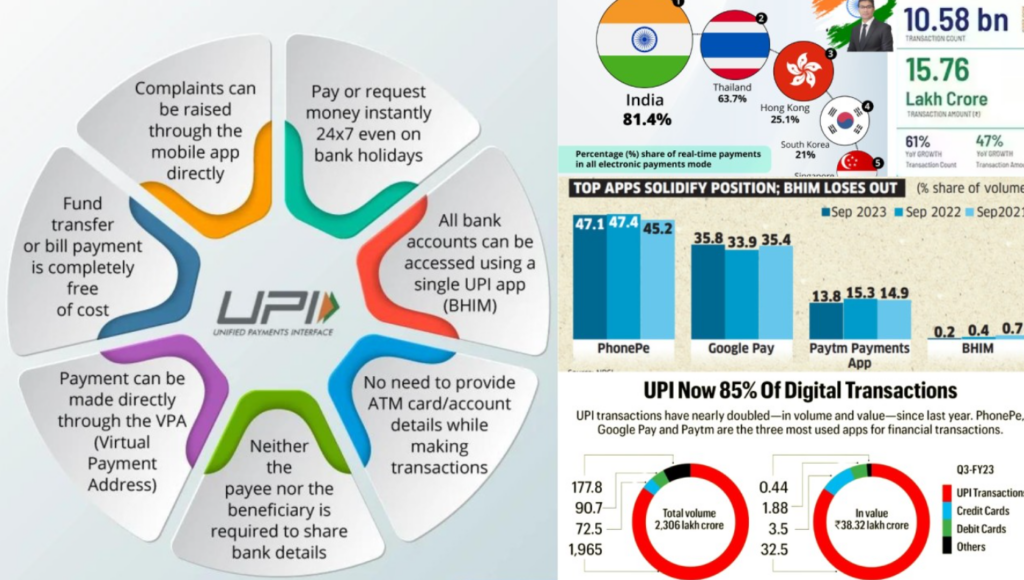
- The UPI is a digital and real-time payment system launched in 2016, developed by the National Payments Corporation of India (NPCI) and regulated by the Reserve Bank of India (RBI).
- It is designed to enable peer-to-peer inter-bank transfers through a single two-click factor authentication process.
- UPI operates as a digital public infrastructure, allowing seamless interactions for all players, including merchants and customers, without transaction costs.
- UPI uses technologies like the Immediate Payment Service (IMPS) and the Aadhaar-Enabled Payment System (AEPS) to ensure that payments between accounts go smoothly.
- Unlike traditional methods, UPI simplifies transfers using the recipient’s UPI ID, be it a mobile number, QR code, or Virtual Payment Address, eliminating account numbers.
- It eliminates the need to enter bank details or other sensitive information each time a customer initiates a transaction.
- A consistent UPI transaction PIN across apps enhances cross-operability, enabling 24/7 transactions.
- It facilitates push (pay) and pull (receive) transactions and even works for over-the-counter or barcode payments, as well as for multiple recurring payments such as utility bills, school fees, and other subscriptions.
UPI Growth: UPI has seen significant growth, with a 45% year-on-year increase in transaction volume, reaching 14.43 billion transactions in July. The transaction value grew by 35% y-o-y to Rs 20.64 lakh crore.
Rationale behind updating transaction limit:
- Easy Tax Payments: This move is expected to further ease and enhance the convenience of tax payments through UPI, which is increasingly becoming the preferred mode of digital payment in India.
- Rationale: Given the commonality of direct and indirect tax payments being regular and high-value, this enhancement aims to facilitate smoother, more secure, and transparent transactions.
- Expert Opinion: Experts noted that this increase will strengthen the tax collection system, reduce costs, and offer more benefits to taxpayers.
4. India underlines elite status with podium finish again
(Source – The Hindu, International Edition – Page No. – 16)
| Context |
|

Analysis of the news:
- India’s men’s hockey team achieved a significant milestone at the Paris Olympics, winning their second consecutive bronze medal by defeating Spain 2-1.
- This triumph marks a continuation of their resurgence in global hockey, having previously ended a four-decade-long Olympic medal drought in Tokyo.
- Coach Craig Fulton’s defence-oriented strategy proved effective, as Harmanpreet Singh’s two penalty corner goals turned the tide after Spain’s early lead.
- The match also served as a farewell for veteran goalkeeper P.R. Sreejesh, whose crucial saves ensured victory.
- This accomplishment underscores India’s return to prominence in international hockey, securing their 13th Olympic medal in the sport.
5. Arshad’s 92.97m dethrones Neeraj
(Source – The Hindu, International Edition – Page No. – 17)
| Context |
|
Analysis of the news:

- At the Paris Olympics, Arshad Nadeem of Pakistan claimed gold in the javelin throw, defeating India’s Neeraj Chopra, the reigning Olympic and world champion.
- Nadeem’s outstanding performance included two record-breaking throws, 92.97m and 91.79m, setting a new Olympic record.
- Neeraj Chopra, despite delivering his season’s best and second-best career throw of 89.45m, had to settle for silver, which marked India’s best result in Paris.


